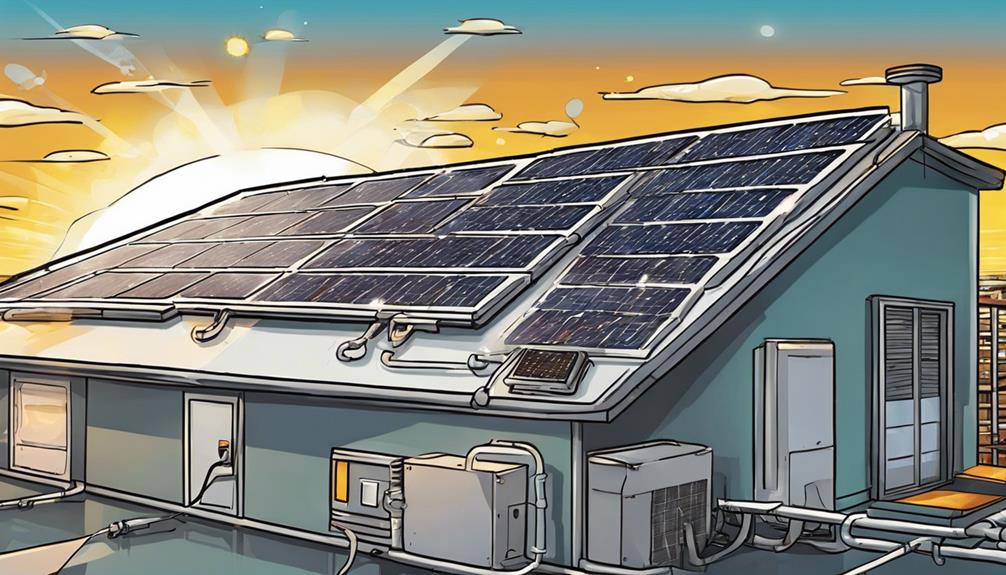If you're curious about the solar power system that turns light energy into electricity, photovoltaic systems with silicon panels are what you need. They can directly convert light into electrical power efficiently. Stick around to discover more about how this incredible process works.
Key Takeaways
- Solar panels with photovoltaic cells directly convert light energy into electrical energy.
- Photons from sunlight are absorbed, generating an electric current.
- This process is based on the photovoltaic effect discovered by Edmond Becquerel.
- The generated electricity can be used or converted for various applications.
- Semiconductor materials like silicon play a crucial role in this energy conversion.
Photovoltaic System Overview
Photovoltaic systems efficiently convert light energy into electrical energy using silicon solar panels. The photovoltaic effect, discovered by French physicist Edmond Becquerel in 1839, allows solar panels to generate direct current (DC) electricity.
This DC power is then converted into alternating current (AC) through inverters for use in households. Photovoltaic systems are versatile, finding applications in both small-scale settings like residential homes and large-scale solar power plants.
Silicon, a common material used in solar panels, plays an essential role in harnessing light energy and transforming it into electrical power. As the global photovoltaic market expands rapidly, solar power is projected to emerge as the leading electricity source worldwide by 2050.
Understanding the fundamental operation of photovoltaic systems is pivotal to harnessing renewable energy efficiently and contributing to a sustainable future.
Solar Panel Functionality
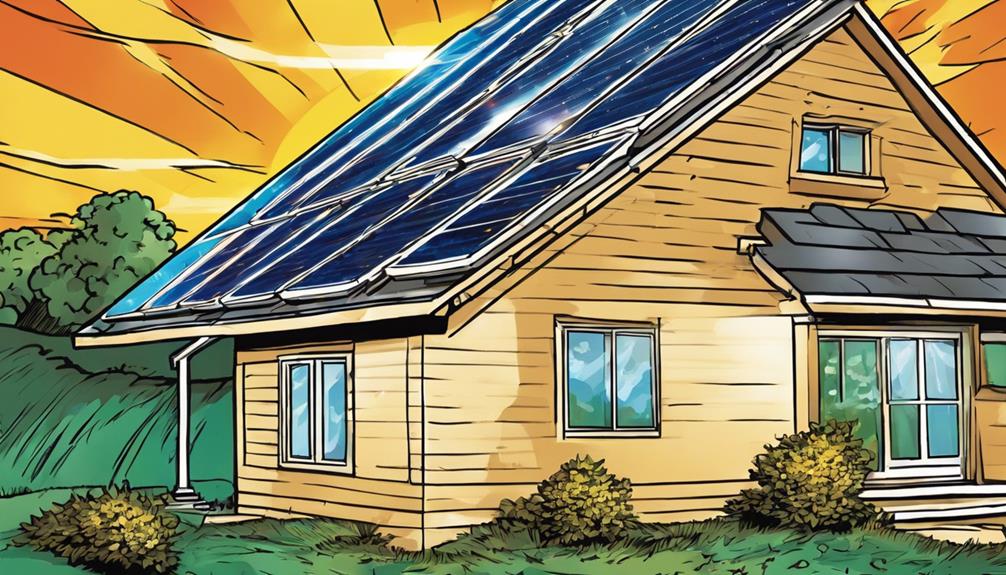
You understand how solar panels function by converting light energy into electrical energy through the photovoltaic effect. Photons from sunlight are absorbed by the photovoltaic cells within the panels, leading to the generation of an electric current.
This process ultimately results in the production of direct current (DC) electricity, which can be converted into alternating current (AC) for various applications in homes and businesses.
Solar Panel Operation
Solar panels operate by converting light energy from the sun directly into electrical energy through the use of photovoltaic cells. These cells utilize the photovoltaic effect, where semiconductor materials like silicon absorb sunlight and produce electricity.
As photons from the sun hit the solar panel, they displace electrons within the semiconductor material, creating an electric current. This direct conversion of light energy into electrical energy enables solar panels to generate electricity efficiently.
Within a solar panel, multiple interconnected photovoltaic cells collaborate to produce usable electrical power. This interconnected network of cells guarantees a continuous flow of electricity as sunlight hits the panel.
Direct Energy Conversion
When sunlight strikes a solar panel, it initiates a process of converting light energy into electrical energy through semiconductor materials. This phenomenon is known as the photovoltaic effect, where semiconductors within the solar cells absorb photons from sunlight and generate an electric current.
This direct energy conversion is the foundation of solar energy systems, allowing them to harness the sun's energy and produce electricity for various applications. The electrical energy produced by the solar panels can be stored or used directly to power homes, businesses, and more.
Solar panels have the capacity to convert sunlight into usable electrical power efficiently, making them an indispensable component of renewable energy systems. Through the utilization of semiconductors and solar cells, photovoltaic systems play a pivotal role in generating electricity from sunlight, contributing to a cleaner and more sustainable energy future.
Electrical Output Generation
The generation of electrical output from solar panels relies on the photovoltaic effect, where sunlight is converted into direct current (DC) electricity.
Solar photovoltaic systems convert light energy into electrical energy through photovoltaic cells. Photovoltaic cells within solar panels absorb sunlight and release electrons to generate electricity.
The electrical output produced by solar panels is in the form of direct current (DC), which can be converted to alternating current (AC) for use in homes and businesses. Solar panels are constructed using semiconductor materials like silicon that enable the conversion of light energy into electrical energy.
The efficiency of solar panel systems in converting light into electricity depends on various factors such as sunlight intensity, panel orientation, and the technology utilized.
Solar Energy Transformation Process
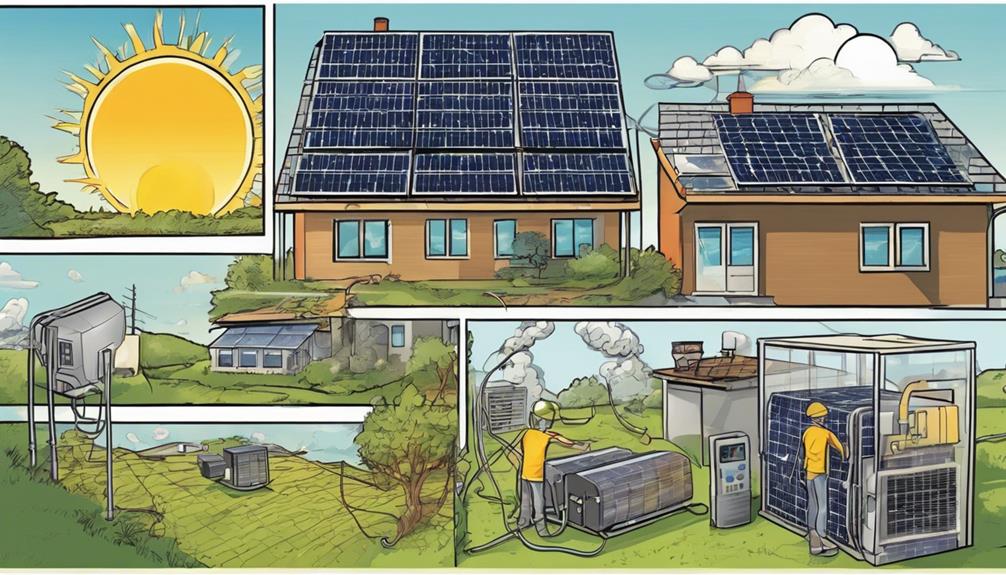
When sunlight hits the silicon solar panels in a photovoltaic system, a direct transformation occurs, converting light energy into electrical energy.
This process happens at the atomic level within the solar cells, where electrical charges are generated by the interaction with sunlight.
These charges then create a flow of electrons, producing usable electricity for various applications.
Direct Electrical Conversion
By utilizing photovoltaic (PV) technology, solar power systems directly convert light energy into electrical energy. PV systems rely on semiconductor materials such as silicon to absorb sunlight and initiate the generation of electricity.
When sunlight reaches the PV cells, photons transfer their energy to the semiconductor material, freeing electrons and creating an electric current. This direct conversion of light energy to electrical energy is the core principle behind solar panels, enabling them to produce electricity without the need for moving parts or complex mechanisms.
PV systems use semiconductor materials like silicon to absorb sunlight and generate electricity.
When photons from sunlight hit the PV cells, electrons are released, creating an electric current.
Direct conversion of light energy into electrical energy is the fundamental principle behind solar panels.
PV systems are widely used to harness solar energy for various applications, from small-scale residential installations to large utility-scale power plants.
Light to Electricity
Harnessing the power of sunlight, solar energy transformation processes involve converting light energy directly into electrical energy through photovoltaic (PV) systems. PV systems utilize solar panels made of semiconductor materials like silicon to facilitate the photovoltaic effect.
When sunlight interacts with the PV cells, electrons are released, initiating an electric current that generates electricity. This electricity is produced in the form of direct current (DC) and is then converted into alternating current (AC) for distribution to homes and businesses.
PV systems play an essential role in both small-scale applications, such as powering devices, and large-scale installations that feed electricity into the grid. By efficiently transforming light into electricity, PV systems contribute to the sustainable generation of clean energy and reduce reliance on traditional power sources.
Photovoltaic Cell Operation
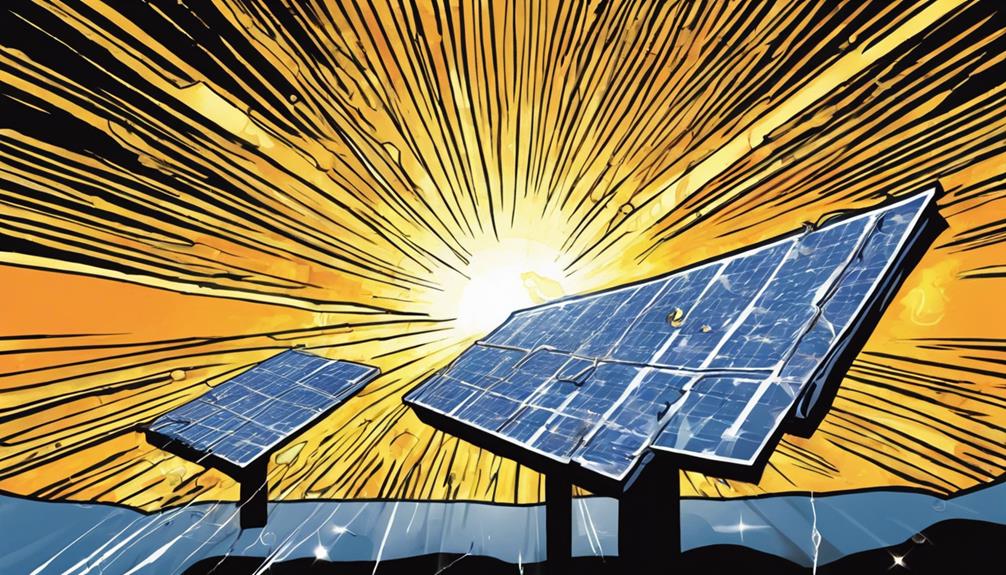
Photovoltaic cells, also known as solar cells, directly convert light energy into electrical energy. When sunlight interacts with the photovoltaic cell, it initiates a process where electrons are released, creating an electric current.
This electric current can then be captured and utilized as electricity for various applications. The mechanism behind this conversion of light energy into electrical energy is known as the photovoltaic effect, a discovery credited to the French physicist Edmond Becquerel in 1839.
- Photovoltaic cells (solar cells) convert light energy into electrical energy.
- Sunlight hitting the cell releases electrons, generating an electric current.
- The electric current produced can be harnessed and used as electricity.
- The photovoltaic effect, discovered by Edmond Becquerel, is the basis for this operation.
Solar Power Generation Mechanism
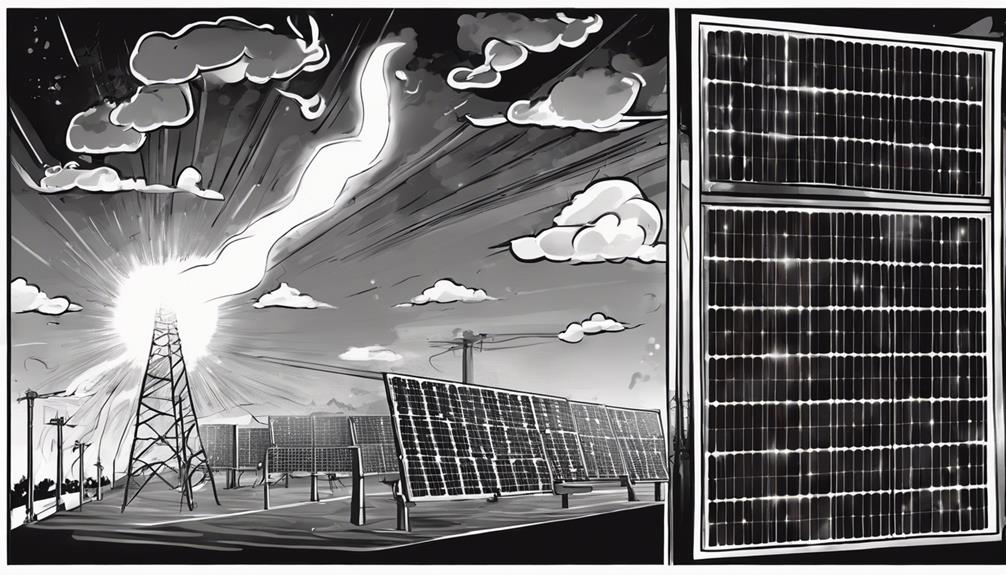
Solar panels, composed of semiconductor materials like silicon, efficiently convert sunlight into electrical energy through a process known as the photovoltaic effect.
When sunlight hits the solar panels, the semiconductor material absorbs the photons and releases electrons, creating an electric current. This direct current (DC) electricity produced by solar panels is then converted into alternating current (AC) through an inverter for use in homes and businesses.
The captured electric charge is channeled through wiring in the solar panels and connected to the electrical grid or stored in batteries for later use. This mechanism allows for the direct conversion of sunlight into usable electrical energy, making photovoltaic systems a sustainable and effective source of power.
Direct Electrical Conversion Process
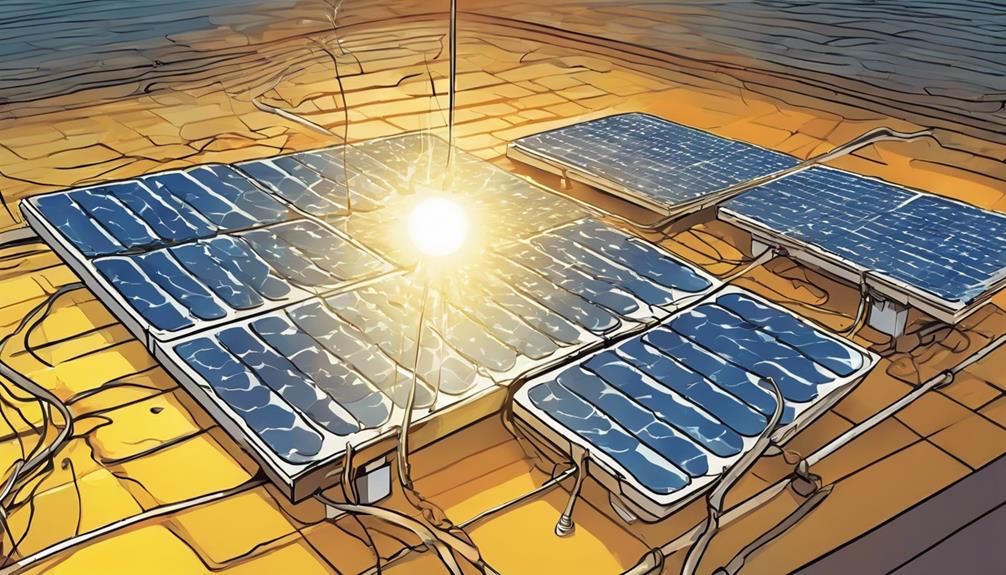
Through the direct electrical conversion process, solar panels efficiently transform light energy into electrical energy. This process is fundamental in photovoltaic systems, where semiconductor materials in solar panels absorb sunlight and generate electric current through the photovoltaic effect discovered by Edmond Becquerel in 1839.
The electricity produced by solar panels is in the form of direct current (DC) and is later converted into alternating current (AC) for use in households. PV systems utilizing this method can range from small-scale installations like residential rooftops to large solar power plants designed for utility-scale electricity generation.
Solar panels: Utilize semiconductor materials to absorb sunlight.
Photovoltaic effect: Basis for converting light energy into electricity.
Direct current (DC): Initial form of electricity generated by solar panels.
Alternating current (AC): Converted from DC for household use.
Solar Panel Technology Basics
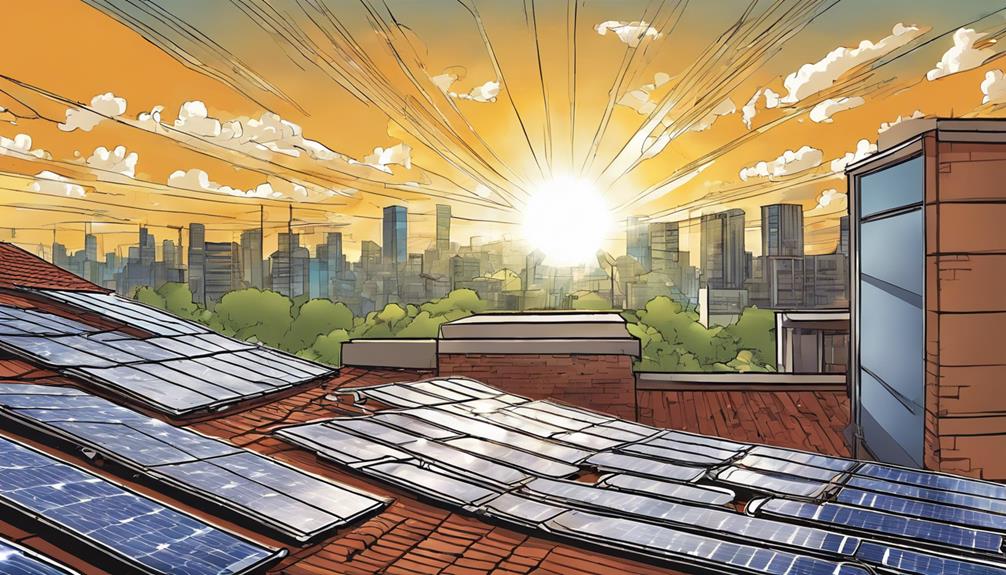
Typically, solar panel technology directly converts light energy into electrical energy through the photovoltaic effect. Photovoltaic cells, made of semiconductor materials like silicon, are key components of solar panels. These cells absorb light energy from the sun and generate electric charges, producing electricity in the form of direct current (DC).
To make this electricity usable for household appliances, inverters are employed to convert the DC power into alternating current (AC).
Understanding the basics of solar panel technology is essential for harnessing clean energy from sunlight. By utilizing the photovoltaic effect, solar panels can efficiently convert light energy into electrical power. The semiconductor materials within the panels play a critical role in this process, enabling the generation of electricity for various applications.
Through the use of inverters, the direct current produced by solar panels can be transformed into the alternating current needed to power homes and businesses effectively.
Light-to-Electricity Conversion Method

Utilizing semiconductor materials like silicon, the light-to-electricity conversion method in photovoltaic systems efficiently transforms sunlight into electrical energy.
In a photovoltaic (PV) system, the process involves the following key elements:
- Semiconductor Materials: PV systems use semiconductor materials like silicon to absorb sunlight and initiate the photovoltaic effect.
- Sunlight Absorption: The semiconductor materials in PV panels absorb sunlight, causing the generation of electrical energy.
- Photovoltaic Effect: Discovered in 1839, the photovoltaic effect is the fundamental mechanism behind converting light energy into electrical energy in PV systems.
- Current Conversion: PV panels produce direct current (DC) electricity, which is then converted into alternating current (AC) for household and commercial applications.
Photovoltaic System Applications
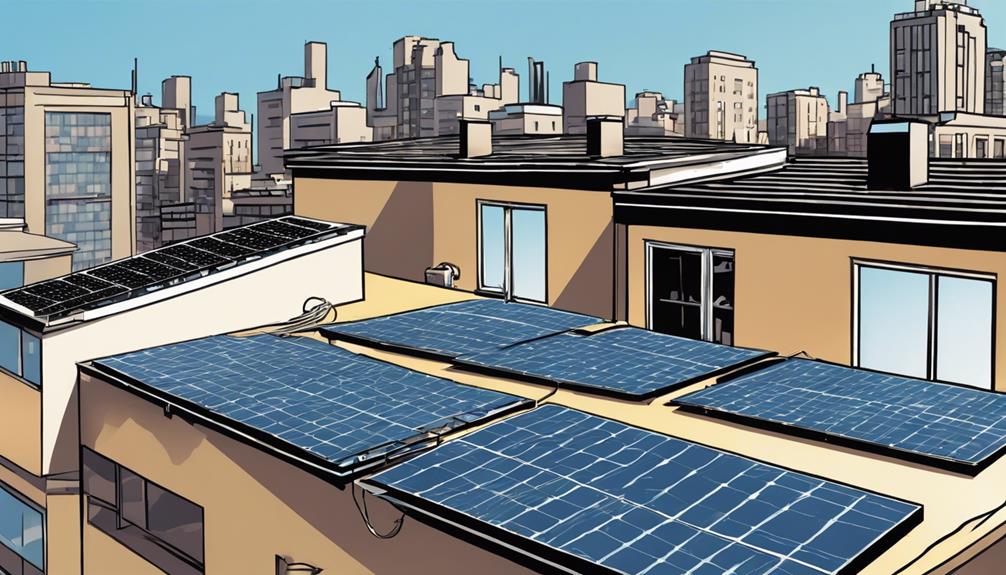
Solar panels in photovoltaic systems are extensively utilized for a variety of applications, ranging from residential to utility-scale settings. These systems play a key role in generating electricity from sunlight, contributing significantly to renewable energy sources.
In residential applications, photovoltaic systems provide homeowners with a sustainable way to power their homes and reduce reliance on traditional energy sources. Commercial applications also benefit from solar panels by lowering operating costs and promoting environmentally friendly practices.
Additionally, in utility-scale applications, large solar farms harness solar energy to generate electricity for communities and industries on a larger scale.
The efficiency and reliability of photovoltaic systems make them a preferred choice for solar energy conversion. By directly converting light energy into electrical energy, these systems offer a clean and sustainable alternative to fossil fuels.
Globally, solar PV technology is widely deployed, demonstrating its importance in the shift towards renewable energy sources. As the demand for clean energy continues to rise, photovoltaic systems are expected to play a vital role in meeting electricity needs while reducing environmental impact.
Frequently Asked Questions
What Solar Device Converts Energy in Light Into Electrical Energy?
You know what solar device converts energy in light into electrical energy? A photovoltaic (PV) system does! Photovoltaic cells in solar panels capture sunlight and turn it into electricity using the photovoltaic effect.
Which Solar Cell Converts the Energy Into Electrical Energy?
When sunlight hits photovoltaic cells, they work their magic by transforming light energy into electrical power. This process, called the photovoltaic effect, lets you harness the sun's energy to generate clean electricity.
Which Solar Technology Converts Light Energy Directly to Electricity?
Solar photovoltaic technology directly converts light energy into electrical energy. Solar panels with photovoltaic cells capture sunlight to generate electric current. They are widely used for various applications, from powering devices to large-scale electricity generation.
What Is the Process Which Converts Solar Radiation Directly Into Electricity Called?
You know what makes solar power so cool? It's the photovoltaic effect! This process converts solar radiation directly into electricity. By using semiconductor materials, sunlight triggers an electric current in photovoltaic systems. Amazing, right?
Is the Type of Solar Power System That Converts Light Energy Directly Into Electrical Energy Related to the Main Source of Energy in the Solar System?
The type of solar power system that converts light energy directly into electrical energy, known as photovoltaic solar cells, is indeed related to the main source of solar energy in our solar system – the sun. This direct conversion allows us to harness the abundant energy provided by the main source of solar energy.
How Does Solar Power System Convert Light Energy into Electrical Energy?
The main source of solar energy, the sun, plays a crucial role in converting light energy into electrical energy through solar power systems. When sunlight hits solar panels, the photovoltaic cells within the panels absorb the photons and generate an electric current, which is then converted into usable electrical energy for powering homes and businesses.
Conclusion
So, there you have it! The photovoltaic system is like a magical sunlight-to-electricity converter, turning the sun's rays into power for your home.
It's like having a little solar superhero on your roof, working tirelessly to keep your lights on and your devices charged.
With this technology, you can harness the power of the sun in a clean and sustainable way.
It's truly amazing what can be accomplished with just a little bit of sunshine!
